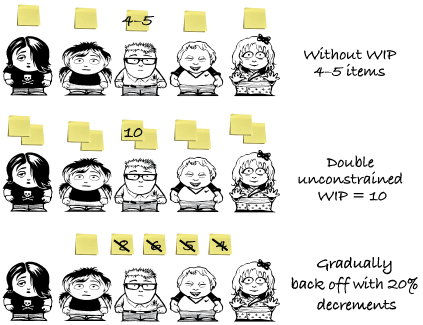Engaging with readers of my book (another one in the works) has been one of the most rewarding aspects of my career shift. The questions and discussions that arise often lead to insightful reflections. Recently, Massimiliano Spolverini posed a thought-provoking query:
In your book, the second rule of thumb for determining WIP limits suggests that setting WIP too high can result in idle work items. However, later, the approach of gradually decreasing WIP (the “Drop down and give me 20” experiment) implies that if too many work items are idle, one should revert to a higher WIP limit. Isn’t this contradictory?
In this post, I aim to address Massimiliano’s question and provide clarity on this matter, acknowledging that there’s no singular answer but rather a spectrum of considerations.
Setting the Context
The chapter in question, Kanban In Action chapter 6, delves into the significance of limiting work in process (WIP), a fundamental tenet of Kanban methodology. In it, my co-author Joakim and I explore strategies for determining appropriate WIP limits, offering two rules of thumb:
- High WIP can lead to idle work: When WIP is excessive, work items may remain untouched, leading to inefficiencies.
- Low WIP can result in idle workers: Conversely, setting WIP too low may leave team members with no tasks, inhibiting productivity.
The “Drop down and give me 20” experiment, referenced by Massimiliano, is a method proposed by Dr. Donald Reinertsen at LKCE 2012. This iterative approach involves gradually reducing WIP limits until problems arise, signifying the threshold of the team’s capacity.

WIP Limits: A Means, Not an End
WIP limits serve as a tool to govern the flow and pace of work within a system. They compel teams to innovate and improve processes to manage constraints effectively. While the rules of thumb provide general guidance, their application is contingent on numerous factors such as team dynamics, work type, and external dependencies.
Consider WIP limits as a continuum rather than fixed parameters. The aim is to strike a balance where neither excessive idleness nor overwhelming busyness prevails. The experimental approach encourages continuous learning and adaptation, emphasizing that WIP limits are not static but evolve with the team’s capabilities.
Addressing the Apparent Contradiction
The apparent contradiction between the rules of thumb and the experimental approach lies in their interpretation. Both caution against extremes: excessive idle items or idle workers. The iterative nature of the “Drop down and give me 20” experiment acknowledges the need for adjustments based on observed outcomes.
Rather than viewing them as conflicting directives, it’s essential to perceive them as complementary strategies for optimizing workflow. Adjusting WIP limits based on observed outcomes is part of the iterative improvement process advocated by Kanban methodology.
Embracing Continual Improvement
Ultimately, the goal is not to adhere rigidly to predetermined WIP limits but to foster a culture of experimentation and learning. WIP limits should be viewed as dynamic tools that evolve in response to changing circumstances and insights.
In conclusion, setting WIP limits involves a nuanced understanding of team dynamics and process intricacies. Experimentation, coupled with thoughtful analysis, enables teams to refine their workflows and achieve optimal performance.
Massimiliano, your question underscores the complexity inherent in WIP limit determination. I hope this response sheds light on the nuanced nature of this aspect of Kanban methodology, emphasizing adaptability and continual improvement.